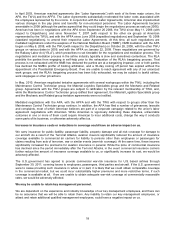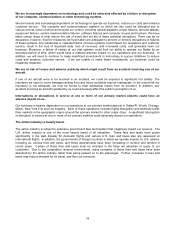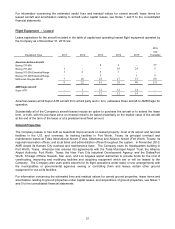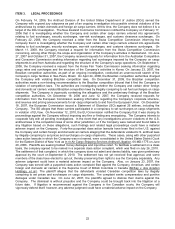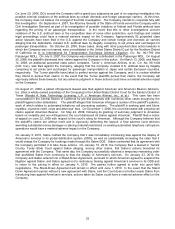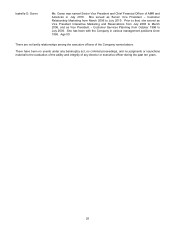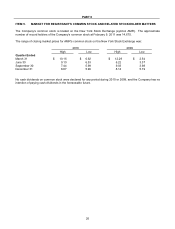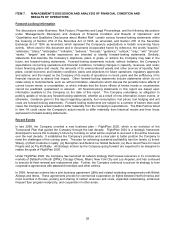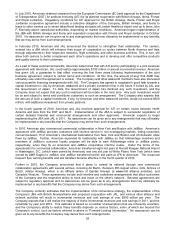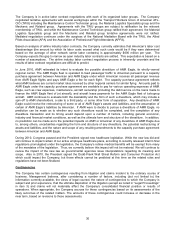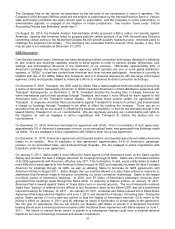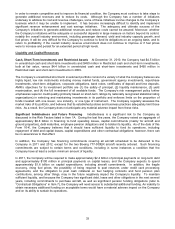American Airlines 2010 Annual Report Download - page 31
Download and view the complete annual report
Please find page 31 of the 2010 American Airlines annual report below. You can navigate through the pages in the report by either clicking on the pages listed below, or by using the keyword search tool below to find specific information within the annual report.
28
ITEM 7. MANAGEMENT'S DISCUSSION AND ANALYSIS OF FINANCIAL CONDITION AND
RESULTS OF OPERATIONS
Forward-Looking Information
The discussions under Business, Risk Factors, Properties and Legal Proceedings, and the following discussions
under “Management's Discussion and Analysis of Financial Condition and Results of Operations” and
“Quantitative and Qualitative Disclosures about Market Risk” contain various forward-looking statements within
the meaning of Section 27A of the Securities Act of 1933, as amended, and Section 21E of the Securities
Exchange Act of 1934, as amended, which represent the Company's expectations or beliefs concerning future
events. When used in this document and in documents incorporated herein by reference, the words "expects,"
“estimates,” "plans," "anticipates," “indicates,” “believes,” “forecast,” “guidance,” “outlook,” “may,” “will,” “should,”
“seeks,” “targets” and similar expressions are intended to identify forward-looking statements. Similarly,
statements that describe the Company’s objectives, plans or goals, or actions the Company may take in the
future, are forward-looking statements. Forward-looking statements include, without limitation, the Company’s
expectations concerning operations and financial conditions, including changes in capacity, revenues, and costs;
future financing plans and needs; the amounts of its unencumbered assets and other sources of liquidity; fleet
plans; overall economic and industry conditions; plans and objectives for future operations; regulatory approvals
and actions; and the impact on the Company of its results of operations in recent years and the sufficiency of its
financial resources to absorb that impact. Other forward-looking statements include statements which do not
relate solely to historical facts, such as, without limitation, statements which discuss the possible future effects of
current known trends or uncertainties, or which indicate that the future effects of known trends or uncertainties
cannot be predicted, guaranteed or assured. All forward-looking statements in this report are based upon
information available to the Company on the date of this report. The Company undertakes no obligation to
publicly update or revise any forward-looking statement, whether as a result of new information, future events, or
otherwise. Guidance given in this report regarding capacity, fuel consumption, fuel prices, fuel hedging and unit
costs are forward-looking statements. Forward-looking statements are subject to a number of factors that could
cause the Company’s actual results to differ materially from the Company’s expectations. The Risk Factors listed
in Item 1A could cause the Company's actual results to differ materially from historical results and from those
expressed in forward-looking statements.
Recent Events
In late 2009, the Company unveiled a new business plan – FlightPlan 2020, which is an evolution of the
Turnaround Plan that guided the Company through the last decade. FlightPlan 2020 is a strategic framework
developed to secure the Company’s future by focusing on what will be required to succeed in the airline business
over the next decade. It establishes the Company’s priorities and a clear plan to better position the Company to
meet the challenges of the coming years. This plan for achieving sustained profitability has five tenets: (i) Invest
Wisely, (ii) Earn Customer Loyalty, (iii) Strengthen and Defend our Global Network, (iv) Be a Good Place for Good
People and (v) Fly Profitably. All strategic actions by the Company going forward are expected to be designed to
realize the goals of FlightPlan 2020.
Under FlightPlan 2020, the Company has launched its network strategy that focuses resources in its cornerstone
markets of Dallas/Fort Worth (DFW), Chicago O'Hare, Miami, New York City and Los Angeles, and has continued
to execute its fleet renewal and replacement plan. Further, the Company continues to pursue its strategy to form
cooperative agreements with oneworld members and other airlines.
In 2008, American entered into a joint business agreement (JBA) and related marketing arrangements with British
Airways and Iberia. These agreements provide for commercial cooperation on flights between North America and
most countries in Europe, pooling and sharing of certain revenues and costs, expanded codesharing, enhanced
frequent flyer program reciprocity, and cooperation in other areas.


